
Imagine you’re choosing a vacation spot. You like the beach, but you also love the mountains. If someone asks which one you prefer, you might struggle to decide. But if they ask you to rank your choices, you can clearly show which one you love the most and which comes second. That’s exactly what ranking questions do in surveys!
Instead of just picking a single option, respondents arrange choices in order of preference, helping you understand what truly matters to them. Whether you’re improving a product, refining the customer experience, or gathering employee feedback, ranking questions reveal deeper insights than simple yes-or-no answers.
Want to know more about effective ranking questions? Here, we will explore the top 25 ranking questions when you need these questions, as well as the best practices for using these questions. Stay with us to learn more about ranking questions!
What are Ranking Questions?
Ranking questions are often used in surveys, quizzes, or research to find out people’s preferences, opinions, or priorities. Instead of asking someone to choose just one answer choice, ranking questions ask them to list options in order of importance, preference, or any other factor.
For example, you’re conducting a survey about your favorite fruits. A ranking question might look like this:
Please rank the following fruits from your most favorite to least favorite:
- Apple
- Banana
- Orange
- Mango
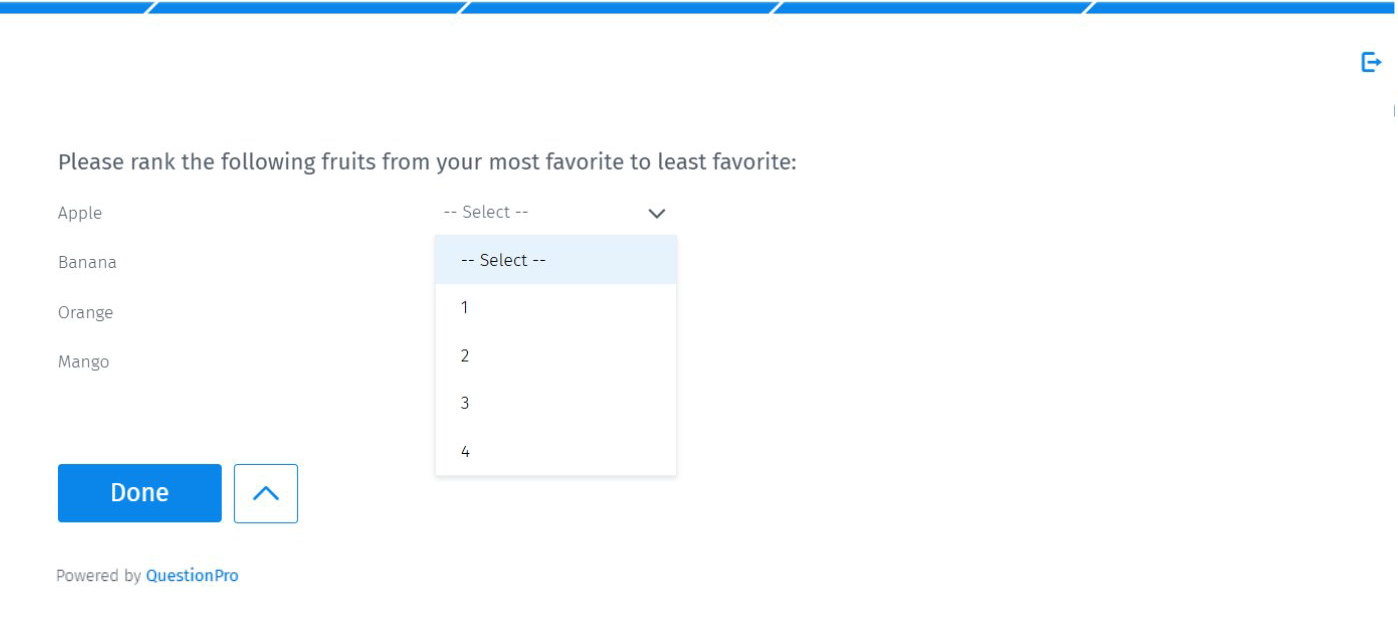
Here, the person would assign numbers to each fruit based on how much they like it. 1 would mean most favorite, 4 would be least favorite, and so on.
The beauty of ranking questions is that they give deeper insight into how people compare different choices. It’s not just about picking the best one but also about understanding how one option stacks up against another.
Ranking questions are especially useful when you want to prioritize certain things, whether it’s products, features, or preferences. They help you gather more detailed and meaningful data than simply asking people to choose one option.
Overall, ranking questions can provide valuable feedback for making decisions in business, research, and even personal preferences.
Learn More: How to use a rank order question in your surveys.
Examples of Ranking Questions
Below, you’ll find a variety of ranking question examples customized to different contexts, from customer satisfaction to employee engagement, to inspire your next survey.
Ranking Questions for Employees
When you use ranking questions with your employees, you’re able to uncover what truly matters to them in the workplace. These questions help you prioritize different aspects, like work-life balance, career growth opportunities, and wellness programs. By understanding your team’s preferences, you can adjust your policies, benefits, and programs to better support them, leading to higher satisfaction, engagement, and retention.
Whether you’re asking about their ideal work environment or the most important aspects of a performance review, ranking questions give you clear, actionable data to create a workplace culture that aligns with your employees’ needs.
01. Work-Life Balance Preferences
Q: Rank the following work-life balance initiatives based on importance.
- Remote work options
- Mental health support programs
- Paid time off and vacation policies
- Employee wellness programs
- Career development opportunities
Understanding employees’ priorities helps organizations offer the right work-life balance benefits to boost satisfaction and retention.
02. Office Perks
Q: Which office perks are most valuable to you?
- Free snacks and beverages
- On-site gym or fitness classes
- Company-sponsored events or social activities
- Quiet workspaces or designated relaxation areas
- Employee discounts or partnerships with local businesses
This question will help you introduce office perks that truly contribute to employee satisfaction and productivity.
03. Annual Review Focus
Q: Rank the aspects of a performance review that matter most to you.
- Clear and constructive feedback on strengths and areas for improvement
- Recognition of achievements and contributions
- Opportunities for career growth and development
- Salary adjustments or bonuses based on performance
- Specific, measurable performance metrics or KPIs
- Support for work-life balance and well-being
By asking this question, you can structure annual reviews in a way that aligns with employees’ expectations and encourages growth.
04. Meeting Preferences
Q: Which factors make meetings more productive?
- Clear agenda and objectives
- Time management
- Active participation from all attendees
- Well-defined roles (e.g., facilitator, note-taker)
- Minimal distractions (e.g., no phone or email checking)
This question will help you organize meetings in a way that respects employees’ preferences and maximizes productivity.
05. Employee Wellness Programs
You can take the initiative for a wellness program in your office and ask your employees for their opinion. Ask them the following question with the possible options about what will benefit them.
Q: Rank the wellness initiatives that would benefit you most.
- Stress Management Workshops
- On-Site Health Screenings
- Subsidized Gym Memberships
- Healthy Office Snacks
- Flexible Work Hours
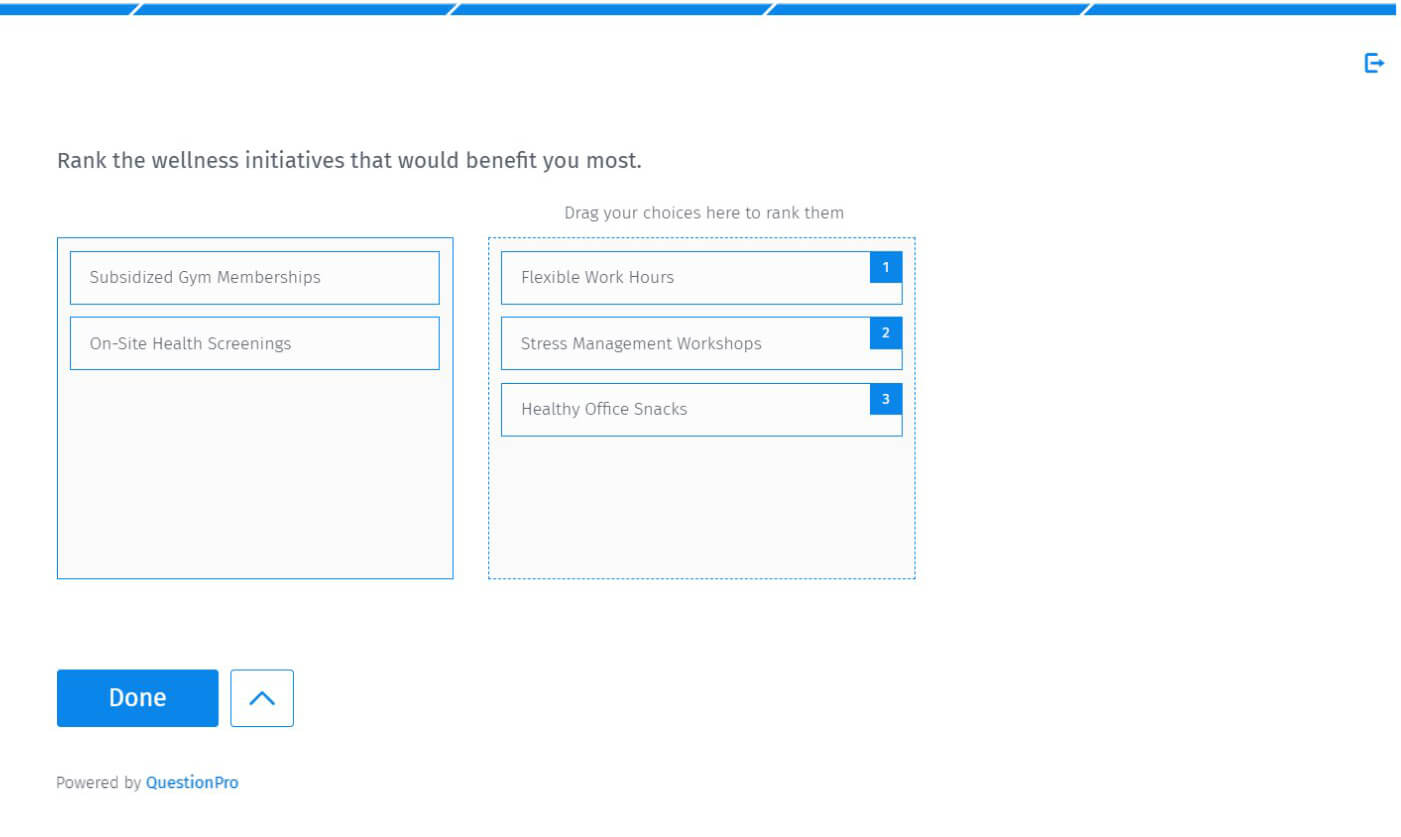
This question will help you implement wellness programs that genuinely support employees’ health.
Learn More: Employee Wellness Survey Questions & Tips.
06. Company Transparency Priorities
Q: Which aspects of company transparency matter most to you?
- Clear communication
- Transparency in decision-making processes
- Openness about financial health and performance
- Regular updates on company performance and progress
- Clear expectations around compensation and benefits
This question will help you focus on the areas where increased transparency will strengthen trust and engagement within your company.
07. Remote Work Challenges
Q: Rank the biggest challenges of remote work for you.
- Feeling isolated or disconnected from the team
- Difficulty in maintaining a work-life balance
- Communication challenges
- Technical issues (e.g., unreliable internet, software problems)
- Difficulty in maintaining a strong company culture remotely
- Distractions or interruptions from the home environment
This question will help you identify areas to address and implement solutions that support employees in a remote work environment.
08. Job Satisfaction Factors
Q: What contributes most to your job satisfaction?
- Opportunities for career growth and development
- Recognition and appreciation for my work
- A positive and supportive work environment
- Competitive salary and benefits
- Challenging and meaningful work
- Job stability and security
By asking this type of ranking question, you can identify key areas to focus on to improve overall job satisfaction and employee retention.
09. Diversity & Inclusion Priorities
Q: Which diversity and inclusion initiatives do you consider most important?
- Inclusive hiring practices
- Equitable pay and compensation
- Bias training and awareness programs for all employees
- Diverse leadership representation in decision-making roles
- Inclusive policies and benefits
Asking this question will help you focus on initiatives that promote a more inclusive and equitable workplace for all employees.
10. Preferred Learning Methods
Q: How do you prefer to develop your professional skills?
- Attending formal training sessions or workshops
- Participating in online courses and webinars
- Receiving mentorship or coaching from senior colleagues
- Collaborating on cross-functional projects for hands-on experience
- Attending conferences and industry events
- Receiving regular feedback from managers and colleagues
To enhance employee development, you can ask employees about the learning methods they find most effective. It will help you customize training and development programs that align with employees’ preferred learning styles and maximize engagement.
Learn More: Top Employee Development Software for Talent Growth.
Ranking Questions for Customers
When you ask customers to rank what’s most important to them, you gain valuable insights into their priorities. Whether it’s product quality, pricing, or customer service, understanding what influences their decisions helps you improve your offerings and marketing strategies.
Ranking questions let you know exactly what matters most so you can tailor your products, services, and customer experiences to exceed their expectations. This kind of feedback also helps you refine loyalty programs, subscription services, or promotional campaigns to boost satisfaction and customer loyalty.
11. Factors Affecting Online Shopping Decisions
Q: What influences your online purchase decisions the most?
- Product reviews and ratings from other customers
- Price and discounts or promotions
- Detailed product descriptions and specifications
- Free shipping or return policies
- Brand reputation and trustworthiness
- Easy and secure payment options
This question will help you identify the key elements that can improve your online shopping experience and increase customer satisfaction.
Learn More: What is Shopping Experience and a guide to improve it.
12. Loyalty Program Preferences
You can enhance your loyalty program by understanding what customers value most. Ask them for their preferences to design a program that truly meets their needs. You can use the following ranking questions:
Q: Which of the following benefits would most influence your decision to join a loyalty program? Please rank them in order of importance (1 = most important, 5 = least important).
- Exclusive Discounts
- Early Access to Sales
- Free Gifts or Samples
- Cashback Rewards
- Birthday Perks
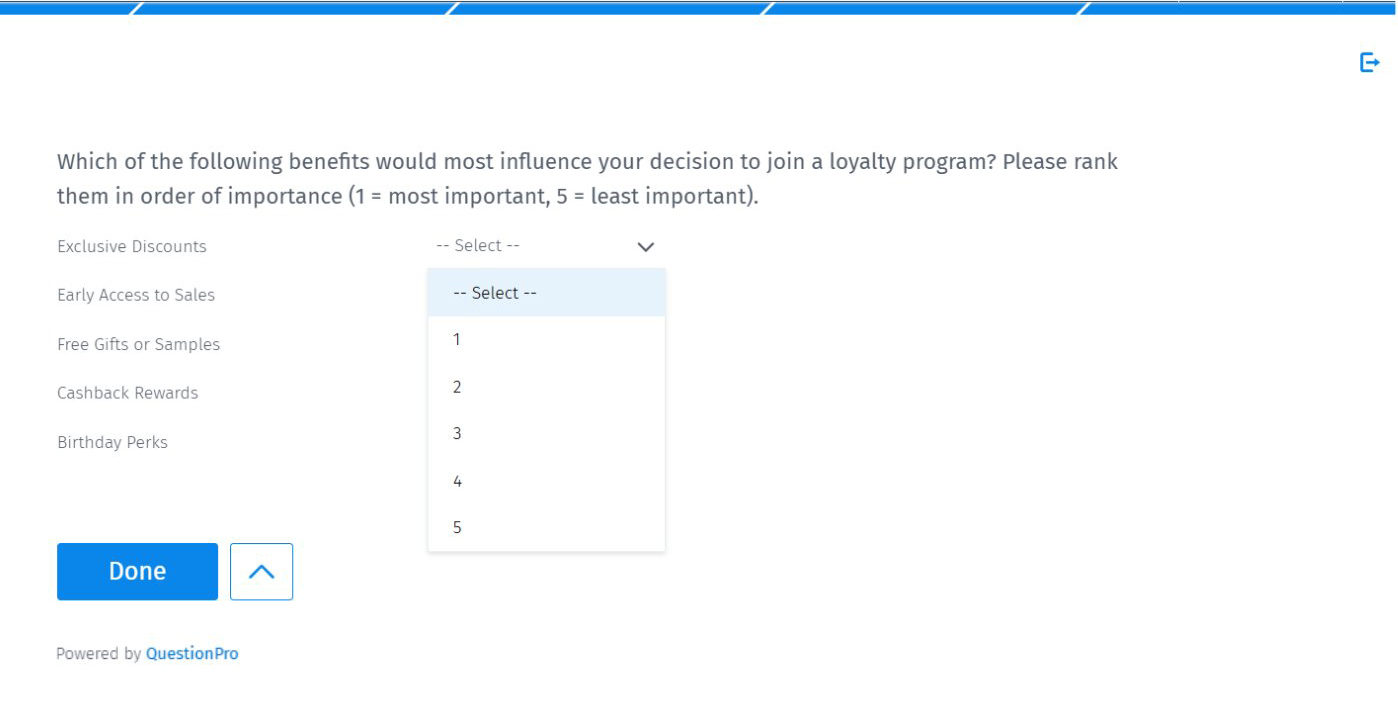
This question helps you customize your loyalty program to boost customer satisfaction and engagement.
13. Subscription Box Features
Q: What do you look for in a subscription box service?
- High-quality and unique products
- Exclusive or limited-edition items
- Eco-friendly or sustainable packaging and products
- Customization options to suit personal preferences
You can ask customers to rank the features they value most to enhance the appeal of your subscription box service.
14. Customer Complaint Resolution Preferences
Q: How would you prefer companies to resolve complaints?
- Acknowledging the issue promptly and with empathy
- Offering a clear and detailed explanation of the problem
- Providing a direct, personal point of contact
- Offering a fair and reasonable solution
- Making the complaint resolution process easy to navigate
- Providing follow-up to ensure the issue was fully resolved
Ask this question to improve customer service policies for faster and more satisfactory resolutions.
Learn More: What is Complaint Resolution and how to handle it.
15. Sustainable Shopping Choices
Q: What factors encourage you to choose eco-friendly products?
- Sustainability of the materials used
- Brand reputation for environmental responsibility
- Product certifications
- Positive environmental impact
- Price competitiveness with non-eco-friendly alternatives
- Long-lasting durability or reusability of the product
To understand what motivates customers to make eco-friendly purchases, you can ask them to rank the factors that influence their sustainable shopping decisions.
Ranking Questions for Market Research & Business
In market research, ranking questions are essential for understanding your customers’ behavior, the effectiveness of your marketing strategies, and how your brand is perceived. By asking your customers to rank various factors—like advertising channels, product features, or trust in your brand—you can gain a clearer picture of what drives their decisions.
This helps you focus on the areas that will make the most impact, whether it’s optimizing your advertising, improving product packaging, or building stronger customer trust. Ranking questions provide the valuable feedback you need to adjust your strategies, improve your products, and position your brand more effectively in the market.
16. Advertising Preferences
Q: Which types of advertisements catch your attention most?
- Interactive or engaging ads (e.g., quizzes, polls, games)
- Humorous or entertaining ads
- Emotional or inspiring ads
- Creative and visually appealing ads
- Ads offering exclusive discounts or promotions
- Ads featuring celebrities or influencers
This question will help you focus on the advertising channels that resonate most with your audience, improving engagement and conversion.
Learn More: Customer Engagement Platforms to boost interaction.
17. Most Trusted Review Platforms
To understand where your customers seek trustworthy reviews, you can ask them to rank the review platforms they trust most. For example, you can ask:
Q: Which platforms do you trust the most for product reviews?
- Amazon
- Google Reviews
- Yelp
- Social media platforms (e.g., Instagram, Facebook, Twitter)
- Influencer or YouTube reviews
This will identify where businesses should focus their online reputation efforts.
18. Product Packaging Preferences
Q: What matters most in product packaging?
- Sustainability (e.g., recyclable, biodegradable, minimal waste)
- Protection (ensuring the product is safe and undamaged during transit)
- Aesthetics (visually appealing and attractive design)
- Functionality (easy to open, store, or use)
- Branding (alignment with the brand’s identity and values)
- Affordability (cost-effective packaging)
Asking this question will help you design packaging that appeals to your customers’ preferences and aligns with their values.
19. Brand Trust Factors
Q: What makes you trust a brand?
- Consistent product quality
- Transparent communication
- Positive customer reviews
- Reliable customer service
- Clear return and refund policies
- Honest advertising
- Brand reputation
To build stronger customer trust, you can ask them to rank the factors that contribute most to their trust in a brand.
Learn More: Boost your brand perception and trust with CX Reputation.
20. Preferred Payment Methods
Q: Which payment methods do you prefer when shopping online?
- Credit or debit card
- PayPal
- Apple Pay or Google Pay
- Buy now, pay later services
- Bank transfer
- Cash on delivery
Optimize your payment options to match your customers’ preferences, making transactions smoother and increasing conversions by asking this question.
21. Streaming Service Preferences
Q: What following features are most important in a streaming service?
- High video and audio quality
- Wide content library
- Affordable subscription plans
- User-friendly interface
- Personalized recommendations
- Multiple device compatibility
- Offline viewing
- No ads or minimal interruptions
- Ability to create multiple user profiles
You can ask them to rank the features they prioritize to better understand what customers value in a streaming service.
22. Grocery Shopping Preferences
Understanding what matters most to shoppers can help improve their experience. You can ask them to rank their grocery shopping preferences to gain valuable insights.
Q: Rank the following factors based on what influences your grocery shopping choices the most (drag and drop from most to least important).
- Price & Discounts
- Organic Options
- Convenience of Store Location
- Brand Loyalty
- Product Quality
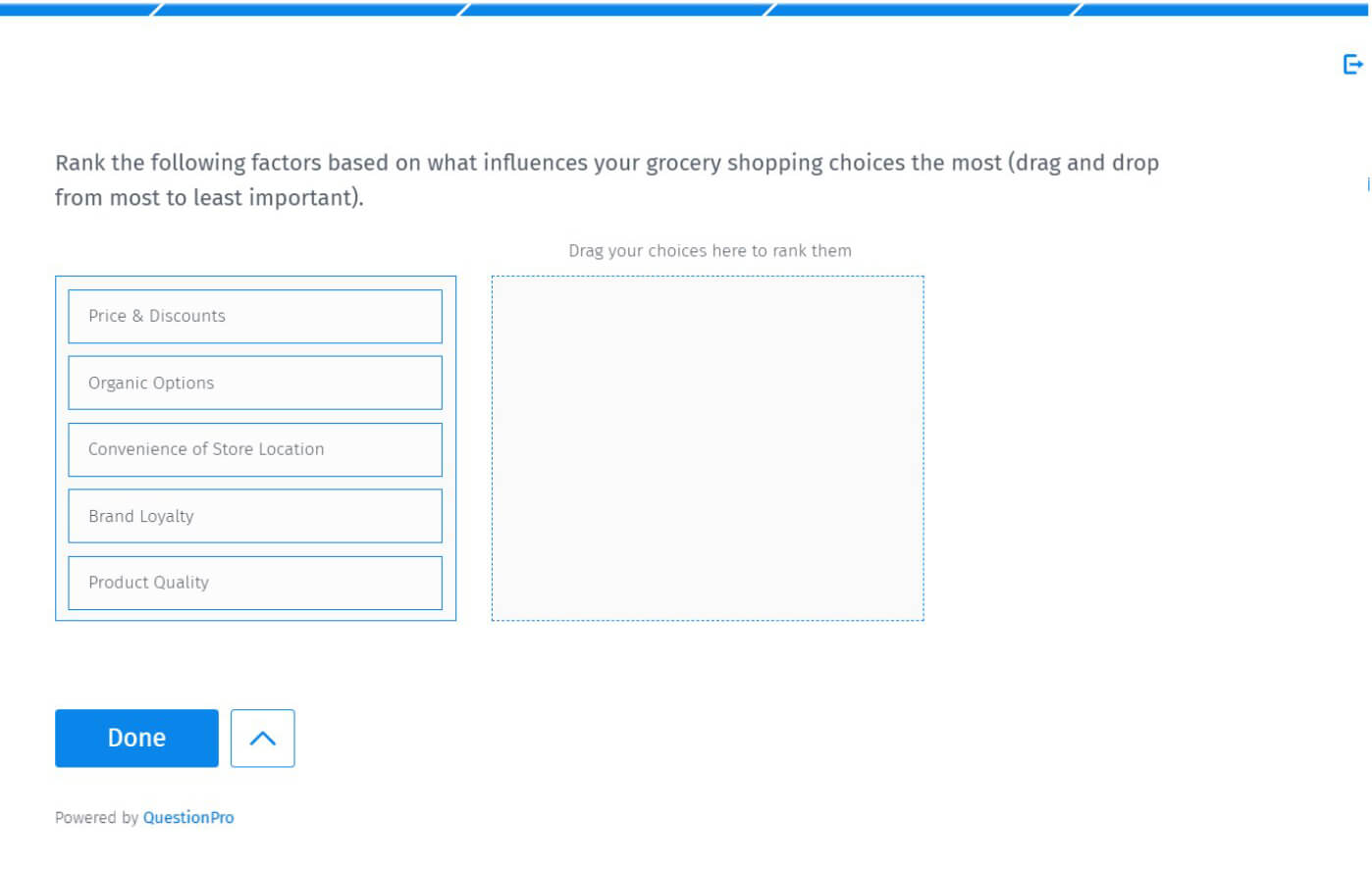
This question helps you optimize the shopping experience to better meet customer needs.
23. Event Ticket Buying Factors
Q: What matters most when buying tickets for events?
- Price and availability of discounts
- Ease of purchase
- Seating options
- Event details
- Customer support in case of issues with the booking
- Refund or exchange policies
This question will help you identify the key elements that attract customers and encourage ticket sales for your events.
24. Reasons for Choosing a Hotel
Q: What factors influence your decision when booking a hotel?
- Price and value for money
- Location
- Reviews and ratings
- Hotel amenities
- Room quality
- Cancellation policies
- Customer service and responsiveness
- Safety and security
You can ask them the question to rank the reasons that matter most when booking a hotel.
25. Preferred Communication Channels for Customer Support
Q: How do you prefer to contact customer support?
- Live chat
- Phone call
- Social media
- Help center or FAQ section
- Contact forms
- Community forums
To provide better customer support, you can ask your customers about their preferred methods of communication.
Each of these closely related areas provides valuable insights for companies to improve employee satisfaction, customer experience, and business decisions.
When You Need Ranking Questions?
You might need ranking survey questions when you want to gather more detailed insights about people’s preferences, priorities, or opinions. Here are some situations where ranking questions are especially useful:
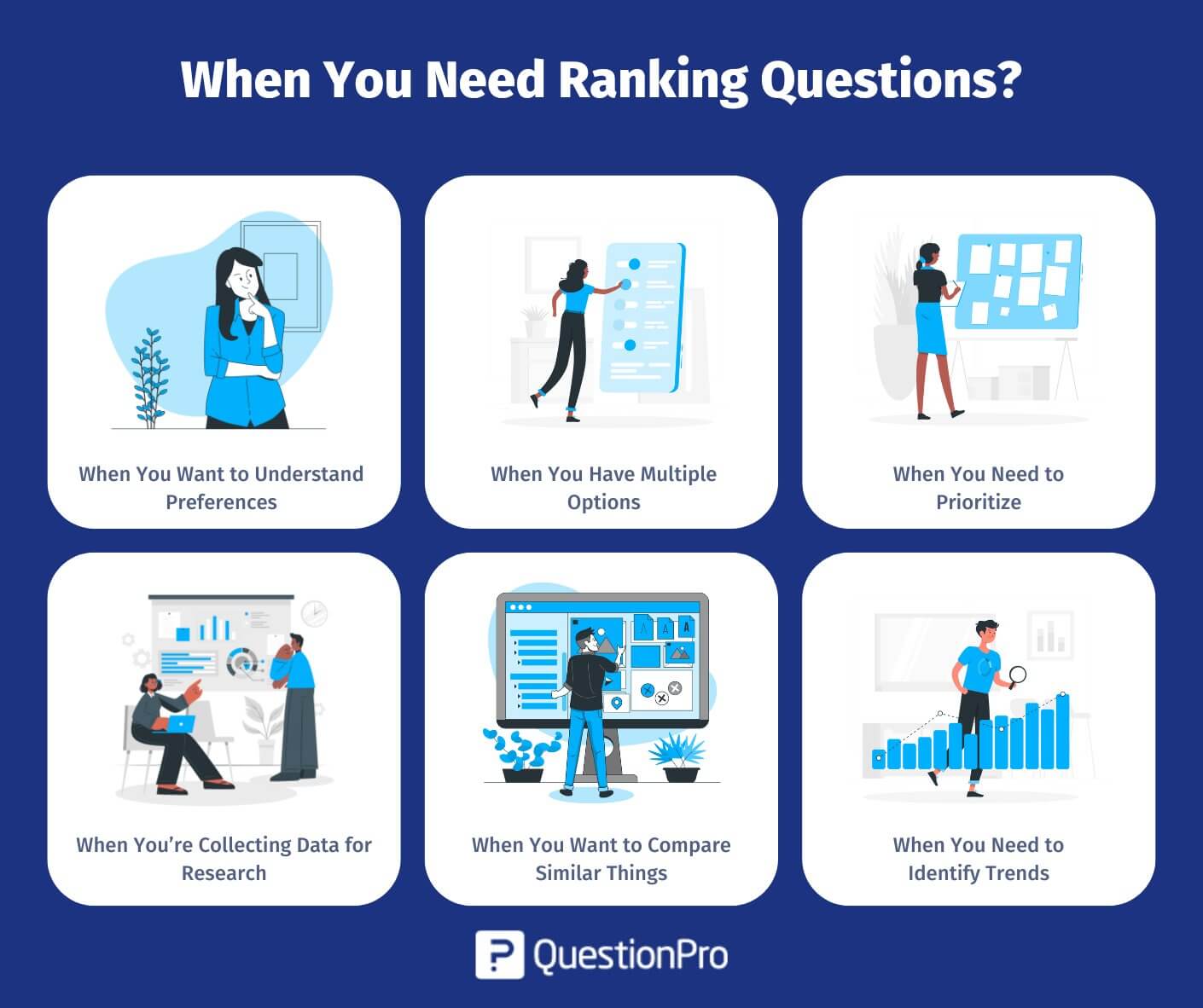
- When You Want to Understand Preferences
Suppose you’re trying to figure out what people like most or least; ranking questions can help. For example, if you’re running a survey about food preferences, asking people to rank dishes from favorite to least favorite gives you a clearer picture of what they truly enjoy.
- When You Have Multiple Options
If you’re offering several choices and want to know how people compare them, ranking questions are perfect.
- When You Need to Prioritize
Ranking questions are great when you need to know what to focus on first. If you’re asking employees to rank different workplace benefits or asking clients to prioritize various aspects of a service, you can use the rankings to figure out what’s most important to them.
- When You’re Collecting Data for Research
In academic research or market research, ranking questions help gather data on preferences, behavior, or opinions. They provide more clear information than just a yes or no answer, making your findings more valuable and insightful.
- When You Want to Compare Similar Things
If you’re comparing products, services, or experiences, ranking questions directly show how they stack up against each other. For example, you might ask customers to rank different smartphone models based on features, design, or price.
- When You Need to Identify Trends
Ranking questions can reveal patterns in data, helping you spot trends over time.
In short, ranking questions are useful when you need to understand how people perceive or prioritize multiple options. They help you gather detailed, comparative data that can drive decisions and improvements.
Ranking Questions vs Rating Questions
When creating surveys, you often come across two common types of questions: ranking and rating questions. While they may seem similar, they serve different purposes and give different types of insights.
Ranking Questions
Ranking questions ask respondents to put items in order based on preference, importance, or priority.
Example of a Ranking Question:
Please rank the following social media platforms from most to least favorite:
- TikTok
What It Tells You:
Ranking questions show comparative preferences, such as what people value the most and least. They help businesses understand priorities when making decisions.
When to Use Ranking Questions?
- To find out what features customers prefer in a product.
- To understand which employee benefits matter the most.
- To determine the most effective marketing strategies.
Rating Questions
Rating questions measure how much a person likes, agrees with, or values something on a given scale. Instead of comparing multiple options, respondents evaluate each option individually based on numeric or descriptive rating scales.
Example of a Rating Question:
How satisfied are you with our customer service?
- Very Dissatisfied
- Unsatisfied
- Neutral
- Satisfied
- Very Satisfied
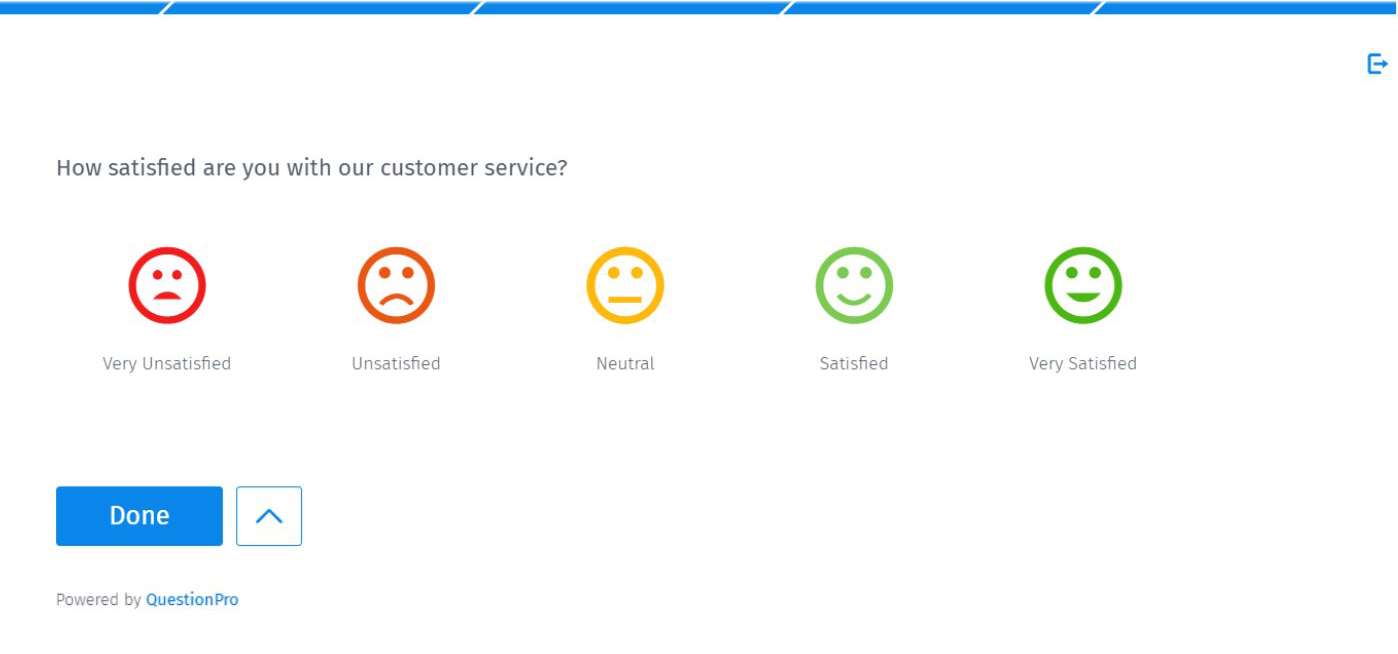
What It Tells You:
Rating questions show absolute opinions, such as how much people like or dislike something without comparing it to other options.
When to Use Rating Questions?
- To measure customer satisfaction with a product or service.
- To evaluate employee engagement and workplace happiness.
- To assess how well a marketing campaign performed.
Key Differences Ranking and Rating Questions
The choice between ranking and rating depends on your goals: Do you want to compare items directly (ranking) or measure individual satisfaction (rating)? Let’s explore when and how to use each method effectively.
| Feature | Ranking Questions | Rating Questions |
| Purpose | Compares multiple options | Evaluates one option at a time |
| Response Type | Puts items in order of preference | Scores each item separately |
| Best for | Understanding priorities | Measuring satisfaction |
| Example | Rank these features in order of importance. | How much do you like this feature on a scale of 1-10? |
Learn More: Rating Scale survey question types and examples.
Best Practices for Using Ranking Questions
Ranking questions are a valuable tool for gathering insights, but using them effectively requires careful planning. Here are some best practices to ensure you get the most out of your ranking questions:
- Keep It Simple: Avoid overwhelming respondents with too many options.
- Limit the Number of Items: Ideally, use 5-7 options to maintain accuracy and engagement.
- Use Clear Wording: Ensure items are distinct and easy to understand.
- Consider Survey Fatigue: Avoid multiple ranking questions in a single survey.
- Analyze Survey Results Properly: Use weighted scoring to interpret data effectively.
How to Create Ranking Survey Questions With QuestionPro?
Ranking questions allow respondents to arrange items in order of preference based on what they value most. This gives you deeper insights into their choices. With QuestionPro, creating ranking questions is quick, easy, and effective. Let’s explore how!
1. Multiple Ranking Styles
QuestionPro offers various ranking styles to suit different survey needs:
- Rank Order: Respondents arrange items in a preferred sequence based on priority or importance.
- Drag and Drop: Users can easily reorder options by dragging them into the desired order.
- Single Answer Ranking: Respondents rank all items in a single list.
- Matrix Ranking: Allows respondents to rank items across multiple categories in a matrix format.
- Rank by Category: Respondents can rank items within specific categories or groups.
2. Customization Options
Every survey is different, and QuestionPro lets you customize your ranking questions:
- Set Minimum & Maximum Ranks: Control how many options respondents must rank.
- Randomize Choices: Prevents bias by changing the order for each respondent.
- Add Images & Videos: Make ranking questions more interactive.
This makes your survey more engaging and accurate!
3. Multi-Device Compatibility
People take surveys on devices like phones, tablets, or desktops. QuestionPro ensures that our ranking questions look great and work smoothly everywhere.
Conclusion
We have learned how ranking questions help gather valuable insights by allowing respondents to prioritize options based on their preferences. Unlike rating questions, ranking questions offer a clearer understanding of what truly matters to individuals by comparing multiple choices.
We explored various examples of ranking questions for employees, customers, and market research, highlighting their real-world applications.
Additionally, we discussed when to use ranking questions, how they differ from rating survey questions, and the best practices for creating effective survey questions. With QuestionPro, you can easily design, customize, and analyze ranking questions to collect meaningful data that drives better decision-making.
By applying these insights, you can create more engaging surveys, improve customer experiences, and refine business strategies. Start using ranking questions today and unlock a deeper understanding of your target audience!
Frequently Asked Questions (FAQs)
Answer: While rating questions ask respondents to evaluate items independently on a scale (e.g., 1 to 5), ranking questions require respondents to compare items directly by ordering them, providing insights into their relative preferences.
Answer: Use ranking questions when you need to understand the relative importance or preference among multiple items, such as product features, service options, or other key factors.
Answer: Ranking questions provide clear insights into respondents’ preferences, allowing for efficient data collection and reducing certain types of response bias by requiring explicit trade-offs between options.
Answer: Limit the number of items to rank (ideally around 5 to 6) to avoid overwhelming respondents. Provide clear instructions and consider randomizing the order of items to minimize bias.
Answer: It is best to keep the number of options between 5-7 to prevent respondent fatigue and ensure accurate responses.







